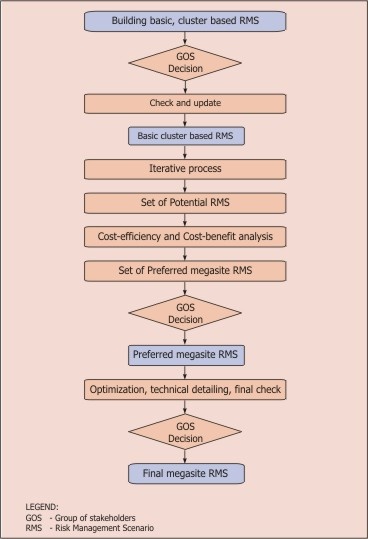Feasibility, priorities and timeframes for intervention actions
The overall objective of this section is to define management scenarios for the megasite that are cost-effective and sustainable. This implies that in the long-term a maximum risk reduction will be achieved within the available budget--taking into account the boundary conditions and criteria.
In order to come to this optimal management scenario at the megasite level, the following activities need to be carried out:
- Define the feasibility of management scenarios for each cluster (including risk reduction objectives and priority)
- Perform cost-efficiency and risk reduction analysis
- Prioritize and optimise management scenarios for the megasite
1. The first step is to analyse the results of the megasite description and to identify the priority clusters and the impact on the receptors. The objectives and priority of management scenarios have to be defined by the stakeholders and depend on both the risk level and the time frame of the impact.
The local situation and characteristics of the contamination determine whether or not techniques can be applied in practice.
2. Based on the feasible measures identified at the cluster level, scenarios have to be defined in which it is specified which measures are taken, when, where and to what extent they affect the contamination (effectiveness). The effectiveness of the scenarios is determined by risk reduction and costs. Depending on the complexity of the situation at the megasite and management scenarios, risk reduction can be calculated in several different ways. It is important to quantify the effect of management scenarios on the contaminant impact at the receptors. In most cases a fate and transport model is needed to make such calculations on a megasite scale and relatively long timeframe. A long-term cost profile can be constructed based on the specifications of the management scenario, the specifications of the measures (e.g. volume of treated groundwater per year) in combination with unit prices. You need to determine the costs of specified scenarios and to make a long term cost profile.
3. The stakeholders decide on a final scenario for the entire megasite. To facilitate this an integral assessment is made at megasite level, including:
- Priority of management scenarios between the different clusters
- Time plan for implementation
- Total costs and risk reduction
- Sustainability factors
- Other boundary conditions and criteria (e.g. redevelopment)
